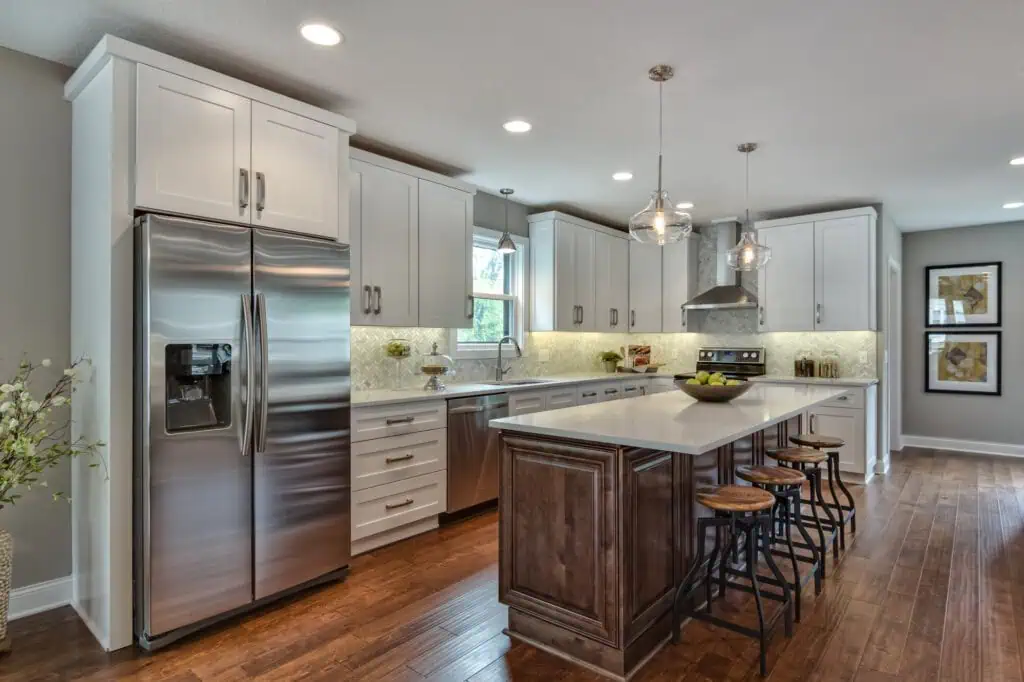Imagine stepping into a home where the aroma of freshly baked cookies wafts through the air, mingling with the sound of laughter from the living room. As you enter, you’re greeted by a spacious, light-filled area where the kitchen, dining, and living spaces flow seamlessly into one another. Welcome to the world of open concept kitchens – a design trend that’s revolutionizing how we live, cook, and entertain.
The Heart of the Home: Understanding Open Concept Kitchens
An open concept kitchen isn’t just a place to cook; it’s the beating heart of your home. By removing walls that traditionally separated cooking spaces from living areas, this design creates a fluid, interconnected space that enhances natural light, improves flow, and fosters social interaction.
Let’s explore some of the benefits that make open concept kitchens so popular:
- Increased natural light: With fewer walls, sunlight can dance freely through your home, creating a brighter, more inviting atmosphere.
- Improved flow and functionality: Moving between cooking, dining, and living areas becomes effortless, making entertaining a breeze.
- Enhanced social interaction: No more feeling isolated while cooking! Open concepts allow you to chat with family and guests while preparing meals.
As Sarah, a Houston homeowner, puts it, “Our open concept kitchen has transformed how we live. I can keep an eye on the kids doing homework while I cook, and when we have friends over, everyone naturally gathers in this space. It’s truly become the heart of our home.”
Designing Your Dream Space: Key Considerations
Ready to embark on your open concept kitchen journey? Let’s dive into the key elements that will shape your new space.
Layout Options: Finding Your Perfect Fit
The layout of your open kitchen will depend on your home’s architecture and your personal preferences. Here are some popular options to consider:
- U-shaped: Ideal for larger spaces, offering ample counter space and storage. Perfect for serious cooks who love having everything within reach.
- L-shaped: Great for corner kitchens, providing an open feel with defined work areas. This layout works well in smaller homes or apartments.
- Island-based: A versatile option that adds extra workspace and creates a natural gathering point. Islands can also house appliances or serve as casual dining spots.
Space Planning: Creating Harmony in Your Open Concept
Effective space planning is crucial in an open concept design. Consider these tips:
- Define zones: Use furniture placement, area rugs, or subtle design cues to clearly delineate cooking, dining, and living areas.
- Optimize traffic flow: Ensure there’s enough space for multiple people to move comfortably between zones. A good rule of thumb is to leave at least 36 inches of walkway space.
- Create visual continuity: Use consistent color schemes, flooring, and design elements to tie the different areas together.
Lighting: Illuminating Your Space
A well-lit kitchen is essential for both functionality and ambiance. Here’s how to light up your open concept space:
- Natural light sources: Maximize windows and consider skylights to flood the space with sunlight. If privacy is a concern, consider frosted glass or stylish window treatments.
- Artificial lighting: Layer your lighting with a mix of:
- Task lighting: Under-cabinet lights or pendant lights over work areas
- Ambient lighting: Recessed ceiling lights or chandeliers
- Accent lighting: LED strips or small lamps to highlight design features
Ventilation: Keeping Your Space Fresh
Proper ventilation is crucial in an open kitchen to prevent cooking odors from permeating living areas. Consider these options:
- Range hoods: Choose a powerful, stylish hood that complements your design. Look for models with at least 350 CFM (cubic feet per minute) of air movement.
- Exhaust fans: Install strategically to improve air circulation. Consider models with humidity sensors for automatic operation.
- Cross-ventilation: Utilize windows and doors to create natural airflow. This can also help reduce energy costs.
The Kitchen Island: Your Multifunctional Centerpiece
A well-designed kitchen island can be the star of your open concept space, serving multiple functions:
- Cooking: Incorporate a cooktop or prep sink for added convenience.
- Dining: Add bar stools for casual meals or a homework station.
- Storage: Utilize the base for drawers, cabinets, or open shelving.
- Socializing: Create a natural gathering spot for family and guests.
When designing your island, consider:
- Size and shape: Ensure it’s proportional to your space and allows for easy movement around it. A good rule of thumb is to leave at least 42 inches of clearance on all sides.
- Materials: Choose durable, attractive surfaces that complement your overall design. Quartz and granite are popular choices for their durability and aesthetic appeal.
- Appliances and features: Think about incorporating a wine fridge, microwave drawer, or built-in cutting board to maximize functionality.
Appliances and Fixtures: Blending Form and Function
In an open concept kitchen, appliances and fixtures play a dual role of functionality and aesthetics. Consider these placement tips:
- Range and oven: Position for easy access while cooking, but be mindful of sight lines from living areas. A statement range can become a focal point of your kitchen.
- Refrigerator: Place near the kitchen’s edge for easy access from both kitchen and dining areas. Consider panel-ready models to blend seamlessly with cabinetry.
- Dishwasher: Install close to the sink for efficient cleanup. Look for quiet models to minimize disruption in your open space.
- Sink and faucet: Choose styles that complement your overall design while offering practical features like pull-down sprayers or touchless operation.
- Countertops: Select materials that are both beautiful and durable, such as quartz or granite. Consider extending the same material to your island for a cohesive look.
Smart Storage Solutions: Keeping Clutter at Bay
With fewer walls for upper cabinets, creative storage solutions become essential in open concept kitchens.
Cabinetry Design: Maximizing Every Inch
- Custom vs. stock cabinets: While custom cabinets offer tailored solutions, well-chosen stock options can be equally effective and more budget-friendly.
- Cabinet materials: Consider durability, ease of cleaning, and how they complement your overall design. Painted cabinets are trending for their versatility and fresh look.
- Storage accessories: Incorporate pull-out organizers, lazy Susans, and drawer dividers to maximize space and keep everything organized.
Pantry Design: A Place for Everything
- Walk-in pantries: If space allows, a walk-in pantry provides ample storage and keeps clutter out of sight.
- Reach-in pantries: Maximize vertical space with adjustable shelving and door organizers.
- Pantry organization: Use clear containers, labels, and tiered shelving to keep items accessible and tidy.
Flooring and Wall Treatments: Unifying Your Space
Choosing the right flooring and wall treatments helps create a cohesive look throughout your open concept space.
Flooring Options: The Foundation of Your Design
- Hardwood: Offers warmth and timeless appeal, but requires regular maintenance. Consider engineered hardwood for better moisture resistance.
- Tile: Durable and easy to clean, available in a wide range of styles. Large format tiles can create a seamless look.
- Luxury Vinyl Plank (LVP): An affordable, low-maintenance option that can mimic more expensive materials while offering excellent durability.
Wall Treatments: Adding Personality
- Paint: Use color to define zones or create a seamless flow between areas. Consider an accent wall to add visual interest.
- Tile: Add texture and interest with a stylish backsplash. Consider extending it to full height for a dramatic effect.
- Wallpaper: Create a focal point or add personality to your space. Removable wallpaper offers flexibility for changing tastes.
Decor and Accessories: The Finishing Touches
The right decor and accessories can tie your open concept kitchen together and reflect your personal style.
- Color schemes: Choose a palette that flows throughout the space, using accent colors to define different zones. Consider the 60-30-10 rule: 60% dominant color, 30% secondary color, and 10% accent color.
- Lighting fixtures: Select statement pieces that complement your design and provide adequate task lighting. Mix and match styles for a curated look.
- Window treatments: Opt for options that allow natural light while providing privacy when needed. Cellular shades or Roman blinds offer a clean, streamlined look.
- Artwork and accessories: Use these elements to add personality and warmth to your space. Consider open shelving to display favorite pieces and add visual interest.
Real-Life Inspiration: Open Concept Success Stories
Let’s look at two successful open concept kitchen designs:
The Urban Loft: Industrial Chic
In this converted warehouse space, industrial elements like exposed brick and ductwork were embraced. A large island with a waterfall countertop serves as a focal point, while sleek, handle-less cabinets maintain a clean, modern look. The homeowner, Mike, shares, “We love how our kitchen reflects the building’s history while feeling completely contemporary and functional.”
The Suburban Family Home: Modern Farmhouse
This renovation opened up a traditional layout, creating a bright, airy space perfect for family life. A farmhouse sink and shaker-style cabinets add charm, while a large island with built-in storage keeps the space organized and functional. “Our open concept kitchen has become command central for our family,” says homeowner Lisa. “It’s where we cook, do homework, and spend quality time together.”
Bringing It All Together: Your Open Concept Kitchen Journey
Creating a successful open concept kitchen requires careful planning and consideration of both aesthetics and functionality. By focusing on layout, lighting, storage, and cohesive design elements, you can create a space that not only looks beautiful but also enhances your daily life and entertaining experiences.
Remember, the key to a great open concept kitchen is balance – between openness and definition, between style and function. With thoughtful design and attention to detail, you can create a kitchen that truly becomes the heart of your home, a space where cooking, dining, and living seamlessly blend into one harmonious experience.
Ready to start your open concept kitchen journey? Here are some next steps:
- Create a vision board with inspiration images and ideas
- Assess your current space and identify your must-haves
- Consult with a professional designer or contractor to bring your vision to life
- Visit showrooms to see materials and appliances in person
- Set a realistic budget and timeline for your project
With careful planning and a clear vision, your dream open concept kitchen is within reach. Happy remodeling!

